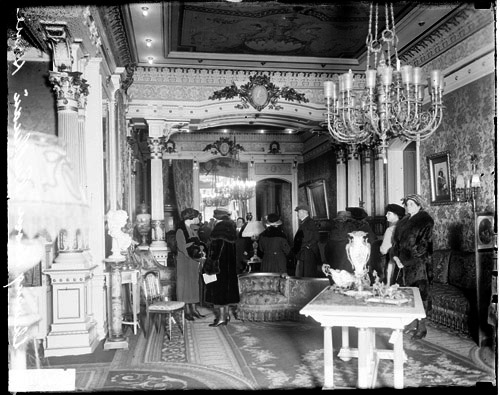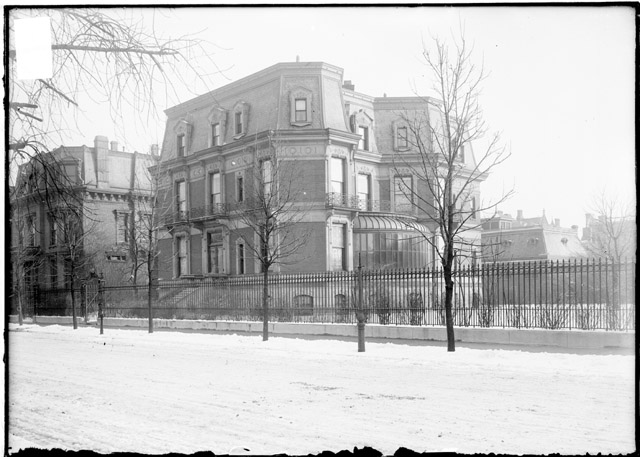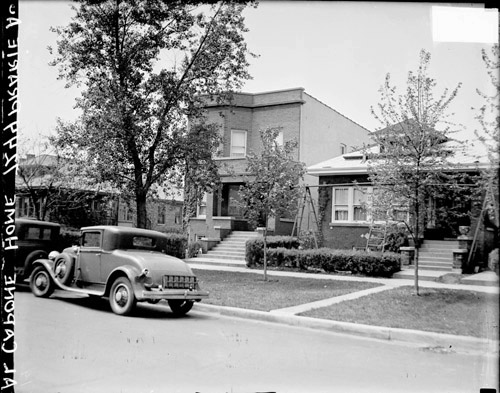- Prairie Avenue
Infobox_road
maint = Department of Streets & Sanitation
highway_name = Prairie Avenue
marker_
| alternate_name = 300 East
length =
direction = North–South at 300 EastHayner, Don and Tom McNamee, "Streetwise Chicago", "Prairie Avenue", p. 105, Loyola University Press, 1988, ISBN 0-8294-0597-6]
direction_a = South
terminus_a = 134th Street 13400 South
direction_b = North
terminus_b = Roosevelt Road (1200 S)
junction =
cities =Chicago
established =
system =Streets and highways of Chicago Prairie Avenue is a north–south thoroughfare on the South Side of Chicago, which historically extended from 16th street in the Near South Side community area of Chicago in Cook County,
Illinois , USA to the city's southern limits and beyond. The street has a rich history from its origins as a majortrail forhorseback rider s andcarriage s. During the last three decades of the 19th century, a six-block section of the street served as the residence of many of Chicago’s elite families and an additional four-block section was also known for grand homes. The upper six-block section includes the historicPrairie Avenue District , which was declared aChicago Landmark and added to theNational Register of Historic Places .Several of Chicago's most important historical figures have lived on the street. This is especially true of the period of recovery from the
Great Chicago Fire of 1871 when many of the most important families in the city moved to the street. Residents of the street have influenced the evolution of the city and have played prominent national and international roles. They have influenced the political history, the architecture, the culture, the economy, as well as thelaw and government of Chicago . The street has over time been influenced by thedemographics of Chicago .The importance of the street has declined, but it still has landmark buildings and is the backbone of an historic district. Additionally, the street is being redeveloped to host valuable and important condominiums. Recently, developments have extended the street north to accommodate new
high-rise condominiums along Roosevelt Road (12th street). The redevelopment has extended the street so that it has prominent buildings bordering Grant Park with Prairie Avenue addresses.History
Prairie Avenue once served as an Indian trail linking
Fort Dearborn to Fort Wayne inIndiana and thus derived its name from the vastmidwest ernprairie land between the two endpoints. In 1812, theFort Dearborn massacre occurred in the area that is now the northern section of the street, in what is known as the Near South Side community area. [cite book|author=Chicago School of Architecture Foundation |coauthors=Prairie Avenue Historic District Committee |title=Prairie Avenue Historic District |accessdate=2007-11-14|year=1975 |month=June ]Over time, the district has evolved from an upscale neighborhood to a factory district and back to an upscale neighborhood. Zoning in 1853 anticipated residential development, although only one grand villa existed at the time. By 1877, the eleven-block area of Prairie Avenue, as well as Calumet Avenue, housed elite residences. By 1886, the finest mansions in the city, each equipped with its own carriage house, stood on Prairie Avenue.cite web|url=http://www.encyclopedia.chicagohistory.org/pages/11413_em.html|accessdate=2007-10-18|author=Conzen, Michael P., Douglas Knox and Dennis McClendon|title=Neighborhood Change: Prairie Avenue, 1853-2003|work=The Electronic Encyclopedia of Chicago|year=2005|publisher=Chicago Historical Society] In the 1880s and 1890s, mansions for
George Pullman ,Marshall Field ,John J. Glessner andPhilip Armour anchored a neighborhood of over fifty mansions known as "Millionaire's Row". However, afterBertha Palmer , society wife ofPotter Palmer , built thePalmer Mansion that anchored the Gold Coast alongLake Shore Drive , the elite residents began to move north.By 1911, warehouses and factories cramped the Prairie Avenue District. Large industry overtook the district by 1950. Early twenty-first century deindustrialization, urban congestion, and historic preservation have brought the return of trendy buildings and restored as well as renovated structures. Simultaneously, new infill housing is resuscitating the district. Now, the historic northern section of the street is part of the
Chicago Landmark Prairie Avenue District that is listed on theNational Register of Historic Places .cite web|url=http://www.ci.chi.il.us/Landmarks/P/PrairieAveDistrict.html|title=Prairie Avenue District|accessdate=2007-10-18|publisher=City of Chicago Department of Planning and Development, Landmarks Division.|year=2003] cite web|url=http://www.nationalregisterofhistoricplaces.com/IL/Cook/state7.html|accessdate=2007-12-06|title=National Register of Historic Places: Illinois - Cook County|publisher=National Register of Historic Places.com|date=] It was declared a Chicago Landmark on December 27, 1979 and added to the National Register of Historic Places on November 15, 1972.cite web|url=http://www.nr.nps.gov/|title=National Register Information System|date=2007-01-23|work=National Register of Historic Places|publisher=National Park Service] The historic district includes the 1800 and 1900-blocks of South Prairie, the 1800 block of South Indiana and 211 through 217 East Cullerton.which was
Background
In the 1850s, railroad related industries prospered near the lumber district along the South Branch of the
Chicago River . Thus, the business district began to supplant the elegant residences along Michigan and Wabash Avenues south of Jackson Boulevard.cite web|url=http://www.encyclopedia.chicagohistory.org/pages/877.html|accessdate=2007-10-18|author=McClendon, Dennis|title=Near South Side|work=The Electronic Encyclopedia of Chicago|year=2005|publisher=Chicago Historical Society] Shortly after the Civil War, the city's wealthy residents settled on Prairie Avenue due to its proximity to the Loop less than a mile away and the fact that traveling there did not involve crossing theChicago River . In 1870,Daniel Thompson erected the first large upper-Prairie Avenue home.Marshall Field followed in 1871 with aRichard Morris Hunt design.cite web|url=http://www.encyclopedia.chicagohistory.org/pages/1003.html|accessdate=2007-10-18|author=Carey, Heidi Pawlaoski|title=Prairie Avenue|work=The Electronic Encyclopedia of Chicago|year=2005|publisher=Chicago Historical Society] Prairie Avenue was the most posh Chicago address by the time of theGreat Chicago Fire of 1871.Many of South Michigan Avenue's elegant villas were destroyed in the
Great Chicago Fire of 1871.cite web|url=http://www.encyclopedia.chicagohistory.org/pages/1767.html|accessdate=2007-10-18|author=Conzen, Michael P. and Douglas Knox|title=Chicago’s Prairie Avenue Elite in 1886|work=The Electronic Encyclopedia of Chicago|year=2005|publisher=Chicago Historical Society] The post-fire South Side ofChicago grew rapidly as all economic classes left the city’s center. Many of Chicago’s elite families settled along Prairie Avenue. By the 1870s and 1880s, Prairie Avenue was the location of elaborate houses between 16th Street and 22nd Street (nowCermak Road ).cite web|url=http://www.encyclopedia.chicagohistory.org/pages/1177.html|accessdate=2007-10-18|author=Pacyga, Dominic A.|title=South Side|work=The Electronic Encyclopedia of Chicago|year=2005|publisher=Chicago Historical Society] In 1886, the urban elite, includingGeorge Pullman ,Marshall Field ,Philip Armour and John B. Sherman all owned family homes in this area that created an opulent Prairie Avenue streetscape reminiscent of European city streets; as such, it was widely regarded as the city's most fashionable neighborhood. Businesses, such as thePullman Company ,Armour & Company andD. H. Burnham & Company , with ties to Prairie Avenue had national and international reach and impact. [cite web|url=http://www.encyclopedia.chicagohistory.org/pages/410064.html|accessdate=2007-10-18|title=Prairie Ave Gallery: The Reach of Prairie Avenue Businesses|work=The Electronic Encyclopedia of Chicago|year=2005|publisher=Chicago Historical Society] Additional grand homes (including manyQueen Anne Style architecture andRichardsonian Romanesque ) were located on Prairie between 26th and 30th Streets starting in the mid-1880s.However, as the turn of the century came, industry’s pervasive reach, increased railroad soot, and an encroaching vice district, caused the area to become less desirable, and the social elite vacated the region for quieter neighborhoods such as Kenwood, the Gold Coast and more commonly the suburban North Shore. The "
Chicago Tribune " highlighted 1898 Prairie Avenue as a place that was undesirable to those for whom it was affordable, and unaffordable to those for whom it was desirable. [cite web|url=http://www.encyclopedia.chicagohistory.org/pages/410058.html|accessdate=2007-10-18|title=Prairie Ave Gallery: Representations|work=The Electronic Encyclopedia of Chicago|year=2005|publisher=Chicago Historical Society] Light industry and vacant lots overtook Prairie Avenue during the second half of the twentieth century. The elegant mansions were mostly torn down or fell into extreme disrepair.Influence
multiple image
align = right
direction = horizontal
header =
header_align = left/right/center
header_background =
footer =
footer_align = left/right/center
footer_background =
width =

width1 = 100
caption1 =George Pullman residence: 1729 S. Prairie Ave. (c. 1900)

width2 = 100
caption2 = Interior of Pullman Residence (1922)

width3 = 110
caption3 = Mercy Hospital: 2537 S. Prairie Ave. (1910) (whereTheodore Roosevelt went after1912-10-14 shooting)

width4 = 110
caption4 =Marshall Field residence: 1905 S. Prairie Ave. (c. 1905)

width5 = 100
caption5 =Al Capone residence: 7244 S. Prairie Ave. (1929)During the 1870s, 1880s and 1890s, upper Prairie Avenue residents were central to cultural and social fabric of the city. The economy was supported by the thousands of jobs created by thePullman Car Company andArmour and Company . Chicago's richest man, Marshall Fields changed the buying habits of the city. John Shorthall saved the property from total chaos after theGreat Chicago Fire by saving property records. At one point in the 1880s, sixteen of the 60 members of theCommercial Club of Chicago lived on Prairie Avenue.George Armour headed the Chicago Academy of Fine Arts, which became theArt Institute of Chicago . [cite web|url=http://www.encyclopedia.chicagohistory.org/pages/10431_em.html|accessdate=2007-10-19|title=The Worlds of Prairie Avenue|work=The Electronic Encyclopedia of Chicago|year=2005|publisher=Chicago Historical Society] 1801 South Prairie resident,William Wallace Kimball , employed about 1500 people at the turn of the century in his organ and piano manufacturing company. [cite web|url=http://www.encyclopedia.chicagohistory.org/pages/2740.html|accessdate=2008-05-12|title=Kimball (W. W.) Co.|work=The Electronic Encyclopedia of Chicago|year=2005|publisher=Chicago Historical Society|author=Wilson, Mark R.]As a home to many of Chicago's leading families, Prairie Avenue became the base of many important political movements. Woman's
suffrage had activists, such as Illinois Women Suffrage Association President Jane Jones, on Prairie Avenue. "Illinois Central Railroad Co. v. State of Illinois", ussc|146|387|1892, pitted the public welfare of the city against the railroad industry and was the foundation for the public trust doctrine which facilitated the city's reclamation of much of the lakefront. Prairie Avenue residents bolstered other efforts to fight against the railroads. The concentration of wealth also made Prairie Avenue the target of complaints about taxation inequities. [cite web|url=http://www.encyclopedia.chicagohistory.org/pages/410065.html|accessdate=2007-10-18|title=Prairie Ave Gallery: Prairie Avenue Politics|work=The Electronic Encyclopedia of Chicago|year=2005|publisher=Chicago Historical Society]Many of these leading families also took part in
philanthropy . John Shorthall, founder of Chicago Title & Trust and Prairie Avenue resident, created the Illinois Society for the Prevention of Cruelty to Animals and convened local and state societies to unite under a national organization (American Society for the Prevention of Cruelty to Animals ) that could combine its political strength and lobby Congress. TheIllinois Institute of Technology was a successor entity of the Armour Institute of Technology, which was an outgrowth of the generosity of Philip andJoseph Armour . [cite web|url=http://www.encyclopedia.chicagohistory.org/pages/410062.html|accessdate=2007-10-18|title=Prairie Ave Gallery: Philanthropies|work=The Electronic Encyclopedia of Chicago|year=2005|publisher=Chicago Historical Society]Preservation
Historic preservation in Chicago has saved some of the city's architectural heritage. The efforts of the
Chicago Architecture Foundation and theLandmarks and Preservation Council of Illinois have been at the forefront of these efforts. TheCommission on Chicago Landmarks (now part of the city’s Department of Planning and Development) has designated the Prairie Avenue Historic District as a city landmark.cite web|url=http://www.encyclopedia.chicagohistory.org/pages/586.html|accessdate=2007-10-18|author=Sciacchitano, Barbara|title=Historic Preservation|work=The Electronic Encyclopedia of Chicago|year=2005|publisher=Chicago Historical Society]A few of the mansions of the heyday still remain in the 1800-block including the National Historic landmark designated
John J. Glessner House designed in 1886 by architectHenry H. Richardson ; these provide a sense of the street's former character. This district includes theHenry B. Clarke House , which although twice relocated is purported to be the city’s oldest standing house. In addition to the Clarke House and the Glessner House, nine other houses from the late-nineteenth century remain in the district. Both the Glessner House and the Clarke House are on theNational Historic Register and now serve as museums. Most of the Prairie Avenue families worshiped at the Chicago LandmarkSecond Presbyterian Church of Chicago , which is listed on the National Register of Historic Places.cite book|title=Chicago Historic Resources Survey: An inventory of Architecturally and historically significant structures|chapter=Community Area #33: Near South Side|pages=258-264|year=1996|author=Commission on Chicago Landmarks and the Chicago Department of Planning and Development]Marshall Field lived at 1905 South Prairie and purchased 1919 South Prairie for Marshall Field, Jr. It is believed that
Solon Spencer Beman had contributed to the design of what is now known as the Marshall Field, Jr. Mansion. Then, Field hiredDaniel Burnham to design extensions and additions to the property after purchasing it 1890.cite web|url=http://www.marshallfieldjrmansion.com/about.php|title=About The Mansion|accessdate=2008-04-07|publisher=marshallfieldjrmansion.com] In 2007, theCommission on Chicago Landmarks announced the rehabilitation of the Marshall Field Jr. Mansion, which had been vacant for 40 years and which was renovated as six private residences, won a Preservation Award. [cite web|url=http://www.aia.org/aiarchitect/thisweek07/0921/0921n_preserve.cfm|title=Chicago Commission Honors 21 Preservation Landmarks|accessdate=2008-04-07|date=2007-09-21 |publisher=American Institute of Architects |work=AIArchitect]Today, Prairie Avenue has buildings indexed in the Chicago Historic Resources Survey in the Near South Side, Douglas, Grand Boulevard, Washington Park and Chatham community areas. [cite book|title=Chicago Historic Resources Survey: An inventory of Architecturally and historically significant structures|chapter=Chapter 2: Address Index|pages=II-32 and II-33|year=1996|author=Commission on Chicago Landmarks and the Chicago Department of Planning and Development] Among the properties listed is a simple two-flat used by Al Capone in the 1920s at 7244 South Prairie in Greater Grand Crossing. [cite book|title=Chicago Historic Resources Survey: An inventory of Architecturally and historically significant structures|chapter=Community Area #69: Greater Grand Crossing|pages=444-447|year=1996|author=Commission on Chicago Landmarks and the Chicago Department of Planning and Development] Other current prominent addresses are the Kimball House at 1801 South Prairie (Near South Side), 2801, 3564, 3566, and 3600 South Prairie (Douglas),cite book|title=Chicago Historic Resources Survey: An inventory of Architecturally and historically significant structures|chapter=Community Area #35: Douglas|pages=268-277|year=1996|author=Commission on Chicago Landmarks and the Chicago Department of Planning and Development] and 4919 South Prairie (Grand Boulevard).cite book|title=Chicago Historic Resources Survey: An inventory of Architecturally and historically significant structures|chapter=Community Area #38: Grand Boulevard|pages=288-295|year=1996|author=Commission on Chicago Landmarks and the Chicago Department of Planning and Development]
A book on the history of the street, entitled "Chicago's Historic Prairie Avenue"was published in June 2008 as part of Arcadia Publishing Co.'s Images of America series.
Today
In 2003, the area redevelopment was well underway.
Deindustrialization andurbanization had pushed outmanufacturing . As a result, factories were generally demolished, or converted toloft apartment buildings. Some neglected mansions survive as restored or renovated properties in the historic district. Today, Prairie Avenue is undergoing a redevelopment that includesOne Museum Park (1215 South Prairie Avenue) andOne Museum Park West (1201 South Prairie Avenue). These Prairie Avenue addresses border theRoosevelt Road side of Grant Park. When completed, One Museum Park will be the tallest building onChicago's South Side and among thetallest buildings in Chicago . It will also surpass340 on the Park as the tallest all-residential building in Chicago,cite web|url=http://www.emporis.com/en/wm/bu/?id=133771|title=One Museum Park|accessdate=2008-05-08|publisher=Emporis.com ] and it will be second to theTrump World Tower in the United States. It will retain this title as tallest all-residential building in Chicago until the completion of theChicago Spire .Notes
External links
* [http://egov.cityofchicago.org/webportal/COCWebPortal/COC_ATTACH/Community_Areas_NEAR_SOUTH_SIDE.pdf Official City of Chicago Near South Side Map]
Wikimedia Foundation. 2010.
